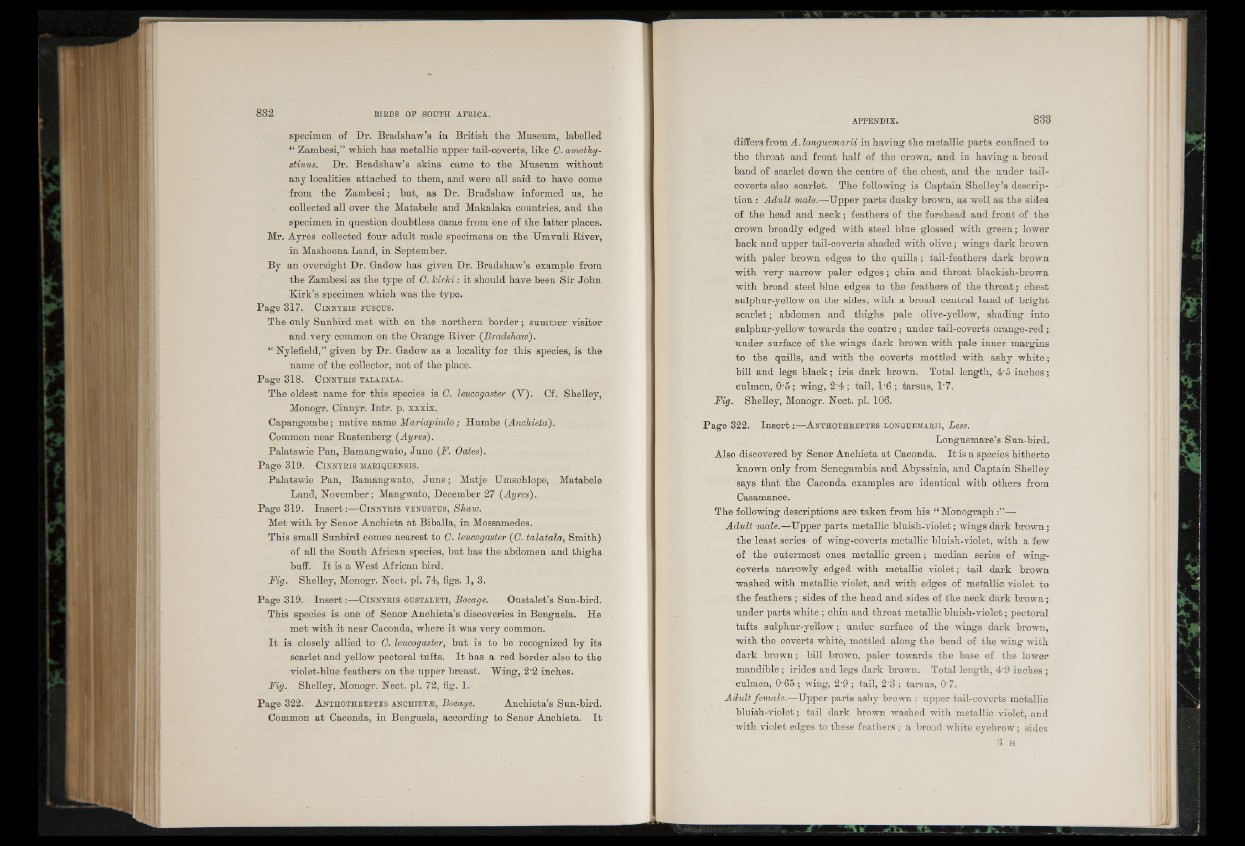
specimen of Dr. Bradshaw's in British the Museum, labelled
“ Zambesi,” which has metallic upper tail-coverts, like 0. amethy-
stinus. Dr. Bradshaw’s skins came to the Museum without
any localities attached to them, and were all said to have come
from the Zambesi; hut, as Dr. Bradshaw informed us, he
collected all over the Matabele and Makalaka countries, and the
specimen in question doubtless came from one of the latter places.
Mr. Ayres collected four adult male specimens on the Umvuli River,
in Mashoona Land, in September.
By an oversight Dr. Gadow has given Dr. Bradshaw’s example from
the Zambesi as the type of 0. hirhi: it should have been Sir John
Kirk’s specimen which was the type.
Page 317. C in n y r is fu s c u s .
The only Sunbird met with on the northern border; summer visitor
and very common on the Orange River (Bradshaw).
“ Nylefield,” given by Dr. Gadow as a locality for this species, is the
name of the collector, not of the place.
Page 318. C in n y r is t a l a t a l a .
The oldest name for this species is G. leucogaster (Y). Of. Shelley,
Monogr. Cinnyr. Intr. p. xxxix.
Capangombe; native name Mariapindo ; Humbe (Anchieta).
Common near Rustenberg (Ayres).
Palatswie Pan, Bamangwato, June (F. Oates).
Page 319. C in n y r is m a riq u e n s is .
Palatswie Pan, Bamangwato, Jun e; Matje Umschlope, Matabele
Land, November; Mangwato, December 27 (Ayres).
Page 319. In s e rt:—C in n y r is v e n u s tu s , Shaw.
Met with by Senor Anchieta at Biballa, in Mossamedes.
This small Sunbird comes nearest to 0. leucogaster (G. talatala, Smith)
of all the South African species, but has the abdomen and thighs
buffi. I t is a West African bird.
Fig. Shelley, Monogr. Nect. pi. 74, figs. 1, 3.
Page 319. Insert :—C in n y r is o u s t a l e t i , Bocage. Oustalet’s Sun-bird.
This species is one of Senor Anchieta’s discoveries in Benguela. He
met with it near Caconda, where it was very common.
I t is closely allied to G. leucogaster, but is to be recognized by its
scarlet and yellow pectoral tufts. I t has a red border also to the
violet-blue feathers on the upper breast. Wing, 2'2 inches.
Fig. Shelley, Monogr. Nect. pi. 72, fig. 1.
Page 322. A n t h o t h r e p t e s an ch ie t.® , Bocage. Anchieta’s Sun-bird.
Common a t Caconda, in Benguela, according to Senor Anchieta. I t
differs from A. longuemarii in having the metallic pai’ts confined to
the throat and front half of the crown, and in having a broad
band of scarlet down the centre of the chest, and the under tail-
coverts also scarlet. The following is Captain Shelley’s description
: Adult male.—Upper parts dusky brown, as well as the sides
of the head and n e c k ; feathers of the forehead and front of the
crown broadly edged with steel blue glossed with green; lower
back and upper tail-coverts shaded with olive; wings dark brown
with paler brown edges to the q u ills; tail-feathers dark brown
with very narrow paler edges; chin and throat blackish-brown
with broad steel blue edges to the feathers of the th ro a t; chest
sulphur-yellow on the sides, with a broad central band of bright
sc a rle t; abdomen and thighs pale olive-yellow, shading into
sulphur-yellow towards the centre; under tail-coverts orange-red ;
under surface of the wings dark brown with pale inner margins
to the quills, and with the coverts mottled with ashy w h ite ;
bill and legs b lack; iris dark brown. Total length, 4'5 inches;
culmen, 0'5 ; wing, 2'4 ; tail, 1’6 ; tarsus, l -7.
Fig. Shelley, Monogr. Nect. pi. 106.
Page 322. In s e r t:—A n t h o t h r e p t e s lo n g u em a r ii, Less.
Longuemare’s Sun-bird.
Also discovered by Senor Anchieta at Caconda. I t is a species hitherto
known only from Senegambia and Abyssinia, and Captain Shelley
says that the Caconda examples are identical with others from
Casamance.
The following descriptions are taken from his “ Monograph —
Adult male.—Upper parts metallic bluish-violet; wings dai’k brown;
the least series of wing-coverts metallic bluish-violet, with a few
of the outermost ones metallic g re en ; median series of wing-
coverts narrowly edged with metallic violet; tail dark brown
washed with metallic violet, and with edges of metallic violet to
the feathers ; sides of the head and sides of the neck dark brown;
under parts white ; chin and throat metallic bluish-violet; pectoral
tufts sulphur-yellow; under surface of the wings dark brown,
with the coverts white, mottled along the bend of the wing with
dark brown; bill brown, paler towards the base of the lower
mandible ; irides and legs dark brown. Total length, 4'9 inches ;
culmen, 0 65 ; wing, 2‘9 ; tail, 2'3 ; tarsus, 0‘7.
Adult female.—Upper parte ashy brown : upper tail-coverts metallic
bluish-violet; tail dark brown washed with metallic violet, and
with violet edges to these feathers ; a broad white eyebrow; sides
3 H